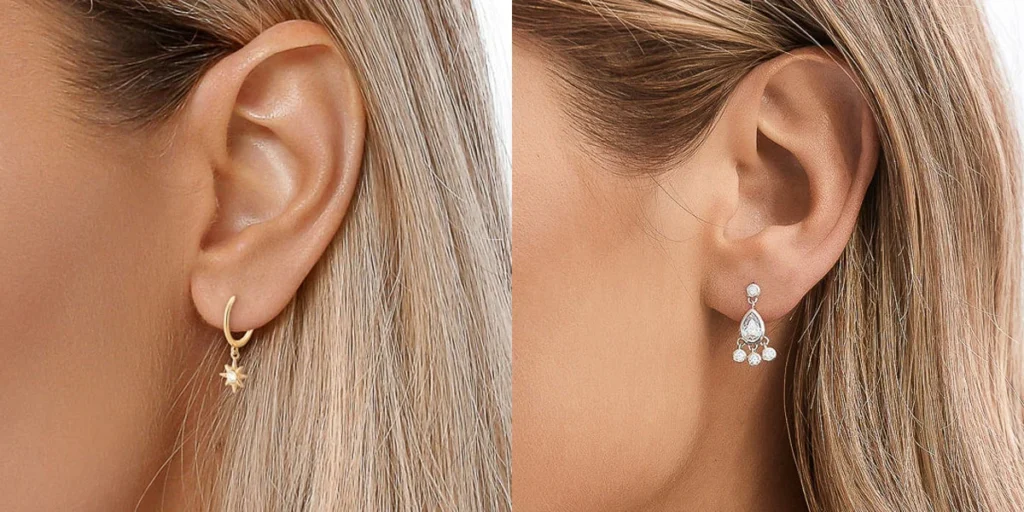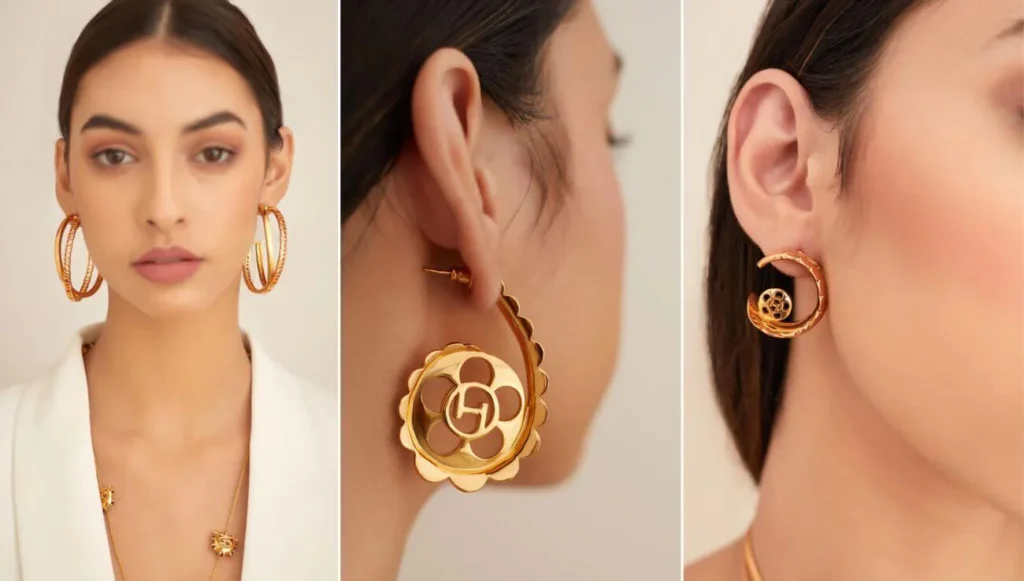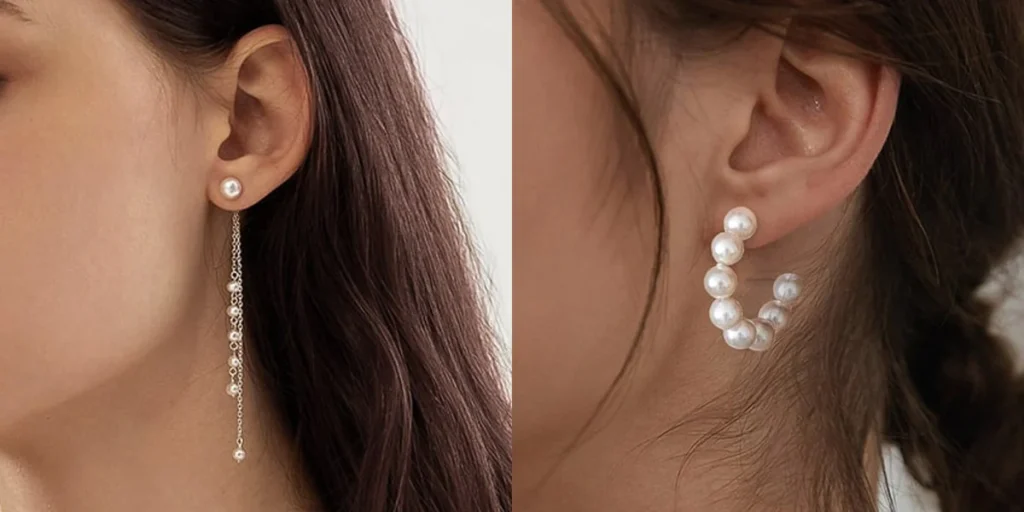Blog
The Most Popular Earring Styles from Around the World
Earrings are one of the oldest and most versatile forms of jewelry, and they have been worn by cultures around the globe for centuries. From delicate studs to elaborate hoops, each region brings its unique flair to this timeless accessory. The diversity in earring styles reflects local traditions, materials, and craftsmanship, making earrings not only a fashion statement but also a symbol of cultural identity.
In this article, we’ll explore the most popular earring styles from around the world, highlighting their history, cultural significance, and modern interpretations.
1. Chandbali Earrings – India

Origin and History
- The chandbali, meaning “moon-shaped” in Hindi, is a traditional Indian earring style inspired by the crescent moon.
- Popularized during the Mughal era, chandbalis feature intricate designs, often adorned with gemstones, pearls, and filigree work.
Modern Appeal
- Today, chandbalis are a staple in Indian bridal jewelry and are often paired with sarees or lehengas.
- Designers have reimagined chandbalis in minimalist forms, making them suitable for casual wear.
Key Features
- Crescent or semi-circular shape.
- Use of gold, kundan, or meenakari work.
- Embellished with dangling pearls or beads.
2. Hoop Earrings – The Americas
Origin and History
- Hoop earrings have ancient roots, dating back to the Sumerian civilization and later embraced by African, Latin American, and Indigenous cultures.
- In Latin America, argollas (hoops) are symbolic of femininity and strength.
Modern Appeal
- Hoops have become a universal favorite, ranging from simple metal designs to oversized, embellished styles.
- Celebrities and fashion icons have brought hoops into mainstream fashion, making them a must-have accessory.
Key Features
- Circular or semi-circular design.
- Materials include gold, silver, and stainless steel.
- Variations include small huggies, medium hoops, and oversized statement hoops.
3. Filigree Earrings – Portugal
Origin and History
- Portuguese filigree earrings are known for their intricate lace-like designs, crafted by skilled artisans.
- The style has its roots in traditional goldsmithing techniques passed down through generations.
Modern Appeal
- These earrings are often worn during festivals and cultural celebrations, adding a touch of elegance to any outfit.
- Contemporary designs incorporate silver and other metals to appeal to a broader audience.
Key Features
- Delicate and lightweight designs.
- Floral or geometric patterns.
- Crafted primarily in gold or silver.
4. Dangling Earrings with Feathers – Native America
Origin and History
- Feather earrings have a deep connection to Native American tribes, symbolizing spirituality, honor, and connection to nature.
- They are often handmade and adorned with beads, stones, or leather accents.
Modern Appeal
- Feather earrings have transcended their cultural origins to become a popular bohemian accessory.
- Their lightweight design and earthy aesthetic make them perfect for festivals and casual wear.
Key Features
- Natural feathers, beads, or turquoise accents.
- Handmade with materials like leather and wire.
- Long, dangling design.
5. Jhumka Earrings – South Asia

Origin and History
- Jhumka earrings have been a part of South Asian culture for centuries, particularly in India, Pakistan, and Bangladesh.
- Their bell-shaped design symbolizes prosperity and is often associated with traditional dance forms.
Modern Appeal
- Jhumkas are now available in lightweight, modern designs for everyday wear.
- They remain a favorite for weddings and festive occasions, paired with ethnic attire.
Key Features
- Bell-shaped structure.
- Made from gold, silver, or oxidized metals.
- Often decorated with intricate carvings and dangling beads.
6. Maasai Beaded Earrings – Africa
Origin and History
- The Maasai people of East Africa are known for their vibrant beadwork, which holds cultural and symbolic significance.
- Beaded earrings are often crafted in bright colors, representing different aspects of Maasai life and traditions.
Modern Appeal
- These earrings have gained global popularity as a symbol of African artistry and heritage.
- Designers incorporate Maasai-inspired beadwork into contemporary jewelry collections.
Key Features
- Bright, colorful beads arranged in patterns.
- Circular or dangling designs.
- Handmade using traditional techniques.
7. Drop Earrings – Europe
Origin and History
- Drop earrings, featuring a single decorative element hanging from a stud, have been a European staple since the Renaissance.
- Historically, they were made with pearls and gemstones to signify wealth and status.
Modern Appeal
- Drop earrings remain a popular choice for formal occasions due to their elegant and versatile design.
- Contemporary styles include minimalist drops and bold, geometric shapes.
Key Features
- Simple yet sophisticated design.
- Use of pearls, diamonds, or gemstones.
- Available in various lengths and shapes.
8. Geometric Earrings – Scandinavia
Origin and History
- Scandinavian design is synonymous with simplicity and functionality, which is reflected in their geometric earrings.
- These earrings often feature clean lines and minimal embellishments.
Modern Appeal
- Geometric earrings are a favorite among minimalists and those seeking a contemporary look.
- They pair well with casual and formal outfits alike.
Key Features
- Shapes like triangles, circles, and squares.
- Materials include silver, gold, and matte finishes.
- Lightweight and comfortable.
9. Korean Minimalist Earrings – East Asia
Origin and History
- Korean jewelry trends emphasize delicate, understated designs that enhance natural beauty.
- Minimalist earrings have become a hallmark of Korean fashion, thanks to the influence of K-pop and K-drama stars.
Modern Appeal
- These earrings are perfect for everyday wear, adding subtle elegance without being overpowering.
- Popular among younger generations for their versatility and affordability.
Key Features
- Simple studs or small hoops.
- Minimal embellishments like a single gemstone.
- Often crafted in rose gold or silver.
10. Clip-On Earrings – Global
Origin and History
- Clip-on earrings gained popularity in the 20th century when pierced ears were less common.
- They allowed people to wear earrings without committing to piercings.
Modern Appeal
- Clip-on earrings are now a popular alternative for those with sensitive ears or unpierced lobes.
- Available in various styles, from vintage-inspired designs to modern minimalist options.
Key Features
- Non-piercing mechanism.
- Wide range of styles, from studs to dangling designs.
- Comfortable for extended wear.
11. Baroque Pearl Earrings – Mediterranean
Origin and History
- Baroque pearls, known for their irregular shapes, have been used in Mediterranean jewelry for centuries.
- They symbolize natural beauty and uniqueness.
Modern Appeal
- Baroque pearl earrings have made a comeback in contemporary fashion, favored for their organic and artistic look.
- They pair well with both casual and formal outfits.
Key Features
- Irregularly shaped pearls.
- Often combined with gold or silver accents.
- Timeless and elegant.
Conclusion
Earrings are more than just accessories—they are cultural artifacts that tell stories of heritage, artistry, and personal expression. From India’s chandbalis to Korea’s minimalist designs, the diversity in earring styles around the world reflects the creativity and craftsmanship of different cultures.
By incorporating these global styles into your collection, you can celebrate the beauty of cultural diversity while staying on-trend. Whether you prefer bold statement pieces or subtle minimalist designs, there’s an earring style for everyone. Explore these iconic looks and find the perfect pair to express your unique style!


